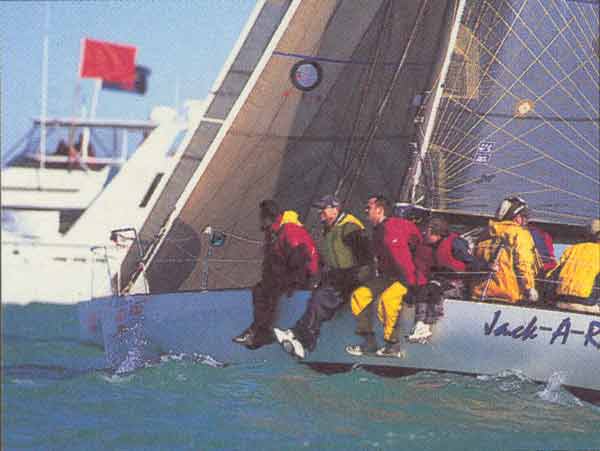 |
| © photo J.H. Peterson |
How
Well Do You Know the New
2005-2008 Racing Rules of Sailing?
by David Dellenbaugh
 |
| © photo J.H. Peterson |
Basic Rules
1) If you’re in the middle of a race and
you see a cruising boat in danger, you
are required to help them if at all
possible. T F
2) A boat can be penalized under the Fair Sailing Rule only if no other rules applies. T F
3) If you are disqualified from a race under the Fair Sailing Rule, you cannot use that score as your throw-out race. T F
4) When you break a rule but no other competitor or race official protests you, you are not required to take a penalty. T F
5) If you participate in a race conducted under the racing rules, you must agree to be governed by those rules T F
6) Class rules are not permitted to
change any of the rules that are in the
rulebook. T F
The Definitions
7) After a boat passes head to wind in
the middle of a tack, she is not
considered to be “on a tack” until she
reaches her new close-hauled course.
T F
8) Two boats on opposite tacks can be overlapped. T F
9) You finish when you cross the finish line in the direction of the course from the last mark, after sailing the course properly. T F
10) If the right-of-way boat can sail a straight course without touching another boat, then the other is keeping clear. T F
11) The anchor line of a mark is not considered to be part of that mark. T F
12) A boat begins to have a proper course when she starts the race. T F
13) A spectator boat is not
considered an obstruction unless a
racing boat has to make a substantial
alteration of course to avoid it.
T F
When Boats Meet
14) The Raving Rules of Sailing begin to
apply between boats before their warning
signal. T F
15) A boat cannot be penalized under the racing rules unless she is racing. T F
16) When a boat that is racing meets a boat that is cruising under sail, the racing boat has right of way. T F
17) When you are raving an you witness a competitor foul a cruising boat, you are not permitted to protest the competitor for that incident. T F
18) When two boats are tacking at the same time, the one that passed head to wind first has right of way. T F
19) If a right-of-way boat fails to avoid contact when possible, whe will not be penalized under rule 14 (Avoiding Contact) unless there is serious damage. T F
20) Rule 14 (Avoiding Contact) applies all the time during a race. T F
21) When right of way changes hands, the new right-of-way boat must always give the other boat room to keep clear. T F
22) Whenever a right-of-way boat changes course during a race, she must give the other boat room to keep clear. T F
23) When a port-tack boat (P) crosses ahead of a starboard tacker (S), S is not permitted to change course if, as a result, P would have to change her course immediately to keep clear. T F
24) When a port-tack boat (P) is ducking to pass behind a starboard tacker (S), S cannot change course if as a result P would have to change her course immediately to keep clear. T F
25) On a beat to windward, a boat cannot sail below her proper course when there is a leeward boat within 2 lengths. T F
26) On a reach, a boat can sail below her proper course as long as there are no boats over-lapped to leeward of her. T F
27) The ‘buoy room’ rule (18) does not apply when boats are on opposite tacks. T F
28) Boats may be “about to round” a mark before they reach the two-length zone. T F
29) If a leeward inside boat has “luffing rights,” she does not have to jibe at a mark to sail her proper course. T F
30) If there is a reasonable doubt that a boat obtained or broke an overlap in time, it shall be presumed that she did not. T F
31) You can hail for room to tack at an obstruction only if you are sailing closehauled. T F
32) You cannot hail for room to tack at an obstruction unless you must make a substantial change of course to clear it. T F
33) You are not permitted to interfere with a boat on another leg of the course. T F
34) A boat doing a penalty turn must keep clear of boats not making penalty turns. T F
35) Once a boat starts moving
backward, she loses all her rights
relative to boats that are not moving
backward. T F
Situations
In each situation below, which boat
(A or B) has the right of way at the
moment shown?
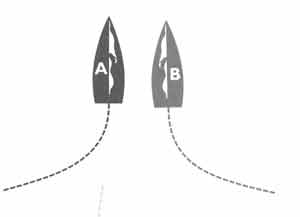 36) Both boats have turned until
they are head to wind.
A B
36) Both boats have turned until
they are head to wind.
A B
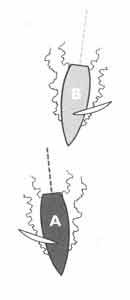 37) Boat B is overtaking boat A from
astern. A B
37) Boat B is overtaking boat A from
astern. A B
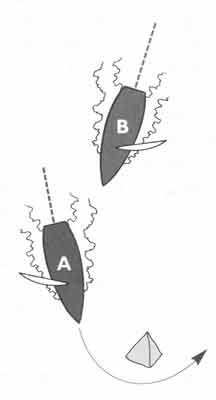 38) Boats A and
B are about to round
the leeward mark.
A B
38) Boats A and
B are about to round
the leeward mark.
A B
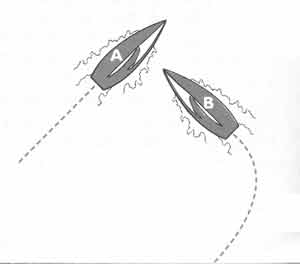 39) Boat B has just completed a tack
very close to Boat A.
A B
39) Boat B has just completed a tack
very close to Boat A.
A B
On which tack is each of the
following boats?
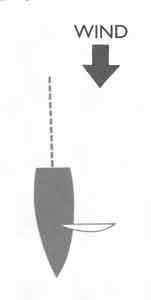 |
40) This boat is sailing dead downwind
with the wind coming straight over its
transom. A. Starboard Tack B. Port Tack C. Neither |
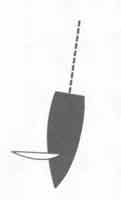 |
41) This boat is sailing by the lee with
the wind coming over its leeward stern
quarter. A. Starboard Tack B. Port Tack C. Neither |
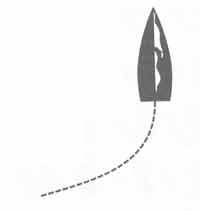 |
42) This boat has turned so it is head
to wind with the wind coming straight
over its bow. A. Starboard Tack B. Port Tack C. Neither |
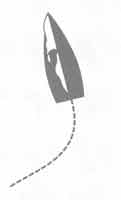 |
43) This boat is in the middle of a tack
and has turned slightly past head to
wind. A. Starboard Tack B. Port Tack C. Neither |
In each of the four situations below, Boat C is overlapped inside Boat D as they approach a leeward or jibe mark. Can C take enough room for a tactical rounding (T), or must she make a seamanlike rounding (S)?
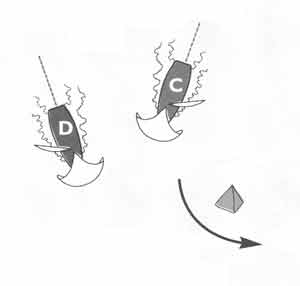 |
44) C is on starboard tack and D is on port tack. T S |
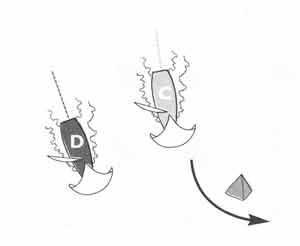 |
45) Both boats are on the same tack (port), with C to windward. T S |
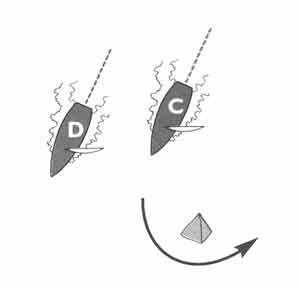 |
46) Both boats are on the same tack (starboard), with C to leeward, C got her overlap from clear astern. T S |
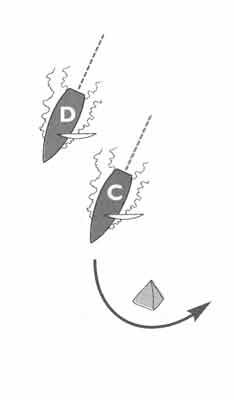 |
47) Both boats are on the same tack (starboard), with C to leeward. C did not get her overlap from clear astern. T S |
Dave publishes the newsletter Speed & Smarts. For a subscription call: 800-356-2200 or go to www.speedandsmarts.com.
Answers
1.True 2.False 3.True 4.False 5.True
6.False 7.False 8.True 9.False 10.False
11.True 12.False 13.False 14.True
15.False 16.False 17.True 18.False
19.True 20.True 21.False 22.False
23.False 24.True 25.False 26.False
27.False 28.True 29.False 30.True
31.False 32.True 33.False 34.True
35.False 36.B 37.B 38.A 39.B 40.A 41.A
42.B 43.A 44.T 45.S 46.T 47.T